Got A Question For Answers? Send It To mcmail@sorc.
Rectified
I have a 1997 Honda CBR1100XX with 55,000 miles on it. I bought the bike new and still love it. I ride it to the mountains, to Daytona Bike Week and to the AMA roadraces at Road Atlanta, despite the fact that it has gone through three stators and voltage regulators. It usually fails at Bike Week or Road Atlanta, which invariably results in an embarrassing push-start to get going again. The electrical system overheats when the temperatures are high and I'm mired in stop-and-go traffic. I am at a loss to figure out how to prevent it.
The problems started about eight years ago, and I had a dealer replace the stator and regulator/rectifier. The next time it was just the R/R, so after reading on some forums that the OEM unit was prone to overheating because it wasn't finned, I tried a CBR900RR unit. When that didn't last, I replaced it with an aftermarket unit, followed by a new aftermarket stator a year later. Now, that combination has failed! The plug into the R/R has several burned contact points, and when I check the stator voltage right from the plug, the best I get is 12 volts. I will be replacing the stator and R/R again, but would like to find a way to avoid this in the future. Any ideas?
Mason Pruner
Deerfield Beach, FL
After sharing your story with a couple of Honda’s wisest “XXperts,” the consensus is that your stator coils have shorted to ground, depriving the regulator/rectifier of its ability to convert AC voltage into the DC kind that charges your battery. That 12V reading at the R/R coupling is low, but without knowing how you’re getting said reading, it’s inconclusive. Testing charging voltage by the book is the best way to determine whether your stator is good or bad.
First, measure battery voltage with the key off. Call that Voltage 1. Now start the engine, hold the tach at 5000 rpm and measure again. That’s Voltage 2, which should be greater then Voltage 1 and less than 15.5V. If V1=V2, check the stator coils for continuity between the three yellow wires and insulation (no continuity) to ground.
_Our friends at Honda suspect that a glitch overlooked during an earlier repair triggered subsequent failures, citing the burned contact points on the R/R coupler as evidence of poor contact caused by corrosion or other contamination. Check your other couplers and ground-wire connections. Heat-damaged terminals should be replaced. Otherwise, a little DeoxIT electronic contact cleaner—available at Radio Shack and elsewhere—should clean things up. If you do end up replacing the regulator/rectifier, make sure you get Honda’s new and improved version (part number 31600-MY7-305) with a larger finned body to dissipate heat more efficiently. _
Euro Tech
I'd like to understand why the Japanese manufacturers fail to give U.S. motorcyclists the same features that European riders find common. The Kawasaki Ninja 1000 sold in America is a really nice sport-touring bike, yet the Europe-only Z1000SX Tourer comes with color-matched Givi bags and available ABS. If I want ABS or traction control, I'm forced to go European or make Kawasaki's new ZX-10R-ABS into a supersport-touring bike. Looking for a bike my wife can grow into as she gains experience, I'm pointed to European makes again, and trying to convince her that Ducati's Diavel would be great for her: relatively lightweight, low seat height and lots of features. Can the Japanese be that far behind in bringing technology to the masses?
Jon Ford
Canyon Lake, TX
_It’s not like there’s any shortage of bright ideas at any of the major Japanese motorcycle manufacturers. Japan, Inc. is basically doing the same thing it’s always done: Aiming its technology where it can make cash registers ring loudest. The global financial meltdown of 2008, along with recent unfavorable dollar/yen exchange rates, hasn’t helped the cause, and the tsunami disaster back in March dealt the whole country a devastating blow. Meanwhile, European brands like Aprilia, BMW, Ducati and Triumph have been coming on strong with bright ideas of their own to pry a larger share of the market away from their Eastern competition. But Honda, Kawasaki, Suzuki and Yamaha have brought more two-wheeled technology to more people over the last 50 years than anybody else. Maybe they’re not bringing all of us everything we want like they did in the Good Old Days, but that will change sooner than later. _
On The Cheap
After reading your Smart Money on Aprilia's second-generation RSV1000R twins, I found a stone-stock 2006 Mille R for sale in the local fish-wrapper for a price too good to pass up. The bike is in great shape with 12,500 miles on the odometer, but it's a little slow compared to my buddy's Ducati 999. What can I do to get a little more power on the cheap without diminishing reliability?
Rodney Ward
Kokomo, IN
According to our go-to Aprilia guru, Amauri Nunes, switching the engine’s command/control ECU to Map Variant 2 and replacing the stock mufflers with something less restrictive will buy you another 5-10 horsepower, and the uncorked engine runs noticeably smoother at no extra charge. “Map Variant 2 runs in open-loop mode,” Nunes explains, “so you don’t have the ECU trying to keep the air/fuel mixture as lean as possible, and ignition timing is optimized for performance instead of being compromised for emissions as in Variant 1. An open airbox is another popular modification, as is disabling the air-intake flapper valve, but neither offers any significant performance benefits.” Nunes adds that the standard 16/40 gearing squelches noise along with performance, so start with a 15-tooth countershaft and take it from there.
Basic Training | FAQ
I'm a beginning rider going for my learner's permit, and training for a full motorcycle license. What is a good streetbike to start on? Or should I start with a dirtbike?
Your training wheels should be light, manageable and unintimidating. Anything that feels too big probably is. If you’re tall enough, a clean, used 250cc dual-sport is agile, forgiving of rookie mistakes and cheaper to fix in the inevitable tip-over. Mastering the basics off-road is a great idea. Dirt is softer than pavement. There are considerably fewer trucks, busses and other potentially painful distractions. And you’ll learn how to cope with dicey surfaces, which puts you at least one giant step ahead of the average street rider. Besides, it’s fun! Start with a trip to the Motorcycle Safety Foundation’s website (www.msf-usa.org), where you’ll find great ways to get started, on or off-road.










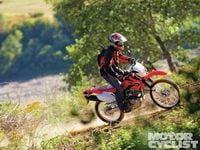
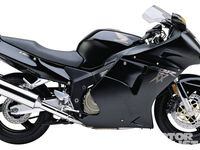
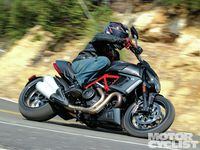
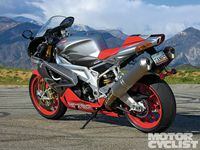
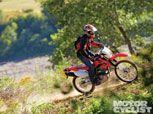
/cloudfront-us-east-1.images.arcpublishing.com/octane/FZXHNOQRNVA3BIDWAF46TSX6I4.jpg)
/cloudfront-us-east-1.images.arcpublishing.com/octane/JRSFLB2645FVNOQAZCKC5LNJY4.jpg)
/cloudfront-us-east-1.images.arcpublishing.com/octane/ITNLTIU5QZARHO733XP4EBTNVE.jpg)
/cloudfront-us-east-1.images.arcpublishing.com/octane/VZZXJQ6U3FESFPZCBVXKFSUG4A.jpg)
/cloudfront-us-east-1.images.arcpublishing.com/octane/QCZEPHQAMRHZPLHTDJBIJVWL3M.jpg)
/cloudfront-us-east-1.images.arcpublishing.com/octane/HXOUJXQWA5HBHGRO3EMJIGFMVI.jpg)

/cloudfront-us-east-1.images.arcpublishing.com/octane/3TIWWRV4JBBOLDVGRYECVVTA7Y.jpg)
/cloudfront-us-east-1.images.arcpublishing.com/octane/KIX5O23D5NAIBGFXBN3327DKZU.jpg)
/cloudfront-us-east-1.images.arcpublishing.com/octane/7GJYDUIPXRGMTMQKN6ONYOLBOU.jpg)
/cloudfront-us-east-1.images.arcpublishing.com/octane/MUQLOVLL2ZDGFH25ILABNBXKTI.jpg)
/cloudfront-us-east-1.images.arcpublishing.com/octane/TNOU5DNE2BC57MFPMGN2EIDXAM.jpg)
/cloudfront-us-east-1.images.arcpublishing.com/octane/GTCXACQGJ5HAPDTGWUQKDEH44E.jpg)
/cloudfront-us-east-1.images.arcpublishing.com/octane/S35YGSEMEZB4BLTDJTSZPF4GLA.jpg)
/cloudfront-us-east-1.images.arcpublishing.com/octane/5UOT6HPX2JFMRJAX6EH45AR4MQ.jpg)
/cloudfront-us-east-1.images.arcpublishing.com/octane/OKWOJWAKP5EP3OACCRRWPCIX2Q.jpg)
/cloudfront-us-east-1.images.arcpublishing.com/octane/2WF3SCE3NFBQXLDNJM7KMXA45E.jpg)
/cloudfront-us-east-1.images.arcpublishing.com/octane/G4MG6OUCJNBSHIS2MVVOTPX65E.jpg)
/cloudfront-us-east-1.images.arcpublishing.com/octane/IIGGWFOTOJGB7DB6DGBXCCMTDY.jpg)
/cloudfront-us-east-1.images.arcpublishing.com/octane/QSTCM6AVEZA5JJBUXNIQ3DSOF4.jpg)
/cloudfront-us-east-1.images.arcpublishing.com/octane/U4I7G625B5DMLF2DVIJDFZVV6M.jpg)
/cloudfront-us-east-1.images.arcpublishing.com/octane/B6XD6LS6IVCQPIU6HXDJSM3FHY.jpg)
/cloudfront-us-east-1.images.arcpublishing.com/octane/ICL63FEDDRDTTMINYICCEYGMDA.jpg)
/cloudfront-us-east-1.images.arcpublishing.com/octane/FCGZHQXRBZFLBAPC5SDIQLVF4I.jpg)